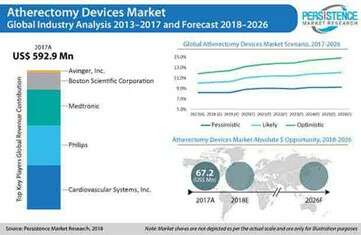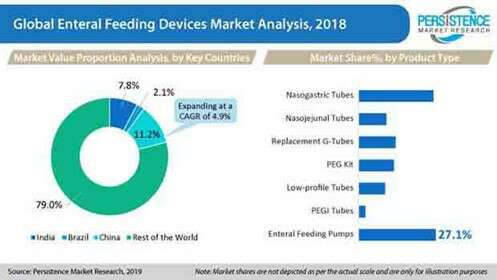
Out of the medical devices available worldwide, the US holds the distinction of being the highest exporter. It is known that medical devices comprise articles, apparatuses, instruments, or machines used to prevent, diagnose, or treat diseases or illnesses, or to detect, measure, restore, correct, or modify structure/function of body. In the US alone, close to 2 Mn people find employment in the medical devices industry.
This counts for more than 30% of the total staff of this industry belongs to the US. The end-users include instrumentation, telecommunications, microelectronics, software development, and biotechnology. Likewise, there are Europe and the Asia-Pacific to follow. In a nutshell, there won’t be anything to look back for the medical devices market in the forecast period.
Also, over 1 Mn people in the UK and 3 Mn people in the US contract pressure ulcers every single year. Heel pressure ulcers rule therein. This calls for heel pressure injury relieving devices. The aged population is more prone to pressure ulcers as they tend to suffer from limited mobility and terminal illnesses. Product-wise, they comprise alternating pressure devices and constant low pressure devices. Based on application, it’s surgery, impaired mobility, neuropathy, diabetes, and others.
Delving deep into the intricacies of human anatomy, MRI guided & focused ultrasound devices are turning out to be indispensable. The developed economies are already into incorporation on their part, but the penetration is less in the developing economies of the Asia-Pacific, especially countries like India, where healthcare infrastructure is still evolving.
Nebulizer devices advocate medication into the lungs in the “misty” form. COPD, cystic fibrosis, asthma, and various other respiratory disorders are addressed through them. On the developments’ front, Philips N.V., in October 2018, did announce launching InnoSpire HO. It comes across as the lightest and smallest portable handheld nebulizer all across the USA, that too, using vibrating mesh technology. As such, those suffering from COPD or asthma are given medication within merely 4 minutes. In the same year, Convexity Scientific Inc. did announce launching Flyp nebulizer. It is a pocket-sized and portable device working on the same principles mentioned above.
The application areas of Lithotripsy devices are bile duct & pancreatic stones, ureteral stones, and kidney stones. Types include intracorporeal (ultrasonic, mechanical, electrohydraulic, and LASER) and extracorporeal shock wave lithotripsy devices. The latter ones are preferred as they are least invasive of all.
Aesthetic lasers and energy devices treat skin damaged due to excessive exposure to sunlight, unwanted lesions, and wrinkles. In other words, the ones desiring rejuvenation of looks go for aesthetic lasers and energy devices. Technology-wise, they comprise LASER-based, light-based (Dynamic Pulse Control technology and Intense Pulsed Light technology), energy-based technology (radiofrequency technology, infrared technology, UV technology, low temperature-based technology, suction based technology, and others). Product-wise, they consist of laser resurfacing devices (fractional ablative skin resurfacing devices and conventional LASER resurfacing devices), body contouring devices (liposuction devices, fat reduction devices, cellulite reduction devices, non-surgical skin tightening devices), and aesthetic ophthalmology devices.

Atherectomy devices play an important role before angioplasty or stenting. They help in debulking lesions and also vessel preparation in the periphery or coronary arteries before going for any of the above-mentioned procedures. Cardiovascular Systems, Inc., in Jan 2021, did receive CE Mark for Diamondback 360 Coronary OAS (Orbital Atherectomy System). The product does contain GlideAssist, which lets easier repositioning, tracking, and removal of the device on being needed. Plus, it could be utilized to treat several calcium modalities. Also, Straub Medical, in Mar 2020, did announce launching Roterex S atherectomy device all over the US. The basic advantage is that it facilitates removal of thrombus and atheroma on simultaneous grounds.
Not to forget – pressure relief devices, which, as per name, do reduce pressure at certain points. This pressure comes out of body weight on resting/sitting on bed. Pressure ulcers could be minimized by these devices as they contain gel, water, air, or foam. These come under low-tech devices. The high-tech devices comprise dynamic air therapy bed and kinetic bed.

Coming to feeding, enteral feeding devices have seen an exorbitant demand due to safety measures taken while making feeding pumps as well as portable and user-friendly ones. Plus, the number of premature births are on the rise. This again calls for enteral feeding devices. They could be enteral feeding pumps or tubes, pertaining to Jejunostomy, Gastrojejunostomy, and gastronomy. There could also be oroenteric feeding tubes, nasoenteric feeding tubes, and enteral syringes.
Persistence Market Research (PMR), through its market study based on “Medical Devices Market”, has profiled the key players as follows:
- Stryker Corporation
- Abbott Laboratories
- GE Healthcare
- Smith & Nephew PLC
- Medtronic PLC
- Boston Scientific Corporation
- Siemens AG


